
In the wild, cats spend their time hunting, marking their territory, defending that territory, grooming and resting.
When we don’t get enough sleep, it can affect our mood, concentration and memory – not to mention our physical health. Getting the recommended eight hours a night can improve our overall quality of life and reduce the risk of disease, hypertension and obesity.
Indoor cats
Choosing to have your cat as an indoor pet can be a great choice for many reasons. It can provide your cat with protection from the elements, and keep them safe from injuries caused by cars, other cats and dangerous animals.
Indoor cats are also less likely to come into contact with diseases, parasites or other health problems than those who go outside. Vaccinations are essential for keeping your cat healthy, as are routine veterinary check-ups and diet modifications if they have any health issues or chronic conditions.
It is also important to ensure that your cat gets adequate exercise as indoor cats are more prone to becoming obese and unfit. This can lead to a number of health complications, including osteoarthritis, heart disease and diabetes.
Outdoor cats
Almost all cats yearn to go outside, but it’s not always a clear-cut decision for owners. Despite a growing number of pet owners allowing their cats unsupervised outdoor access, there are some welfare concerns associated with free-roaming cat populations, including increased risks of disease and parasites, injury or death from traffic, predatory behaviors, and getting permanently separated from their owners.
To mitigate these welfare risks, some animal welfare organizations recommend limiting free-roaming outdoor access to cats. These restrictions may improve cat welfare by reducing the risk of a variety of hazards, including predatory behavior, predation on wildlife, and injuries from traffic accidents.
Multi-cat households
The trend in cat ownership has been increasing over recent years, and a large proportion of households now keep more than one feline. These multi-cat households can be challenging to manage.
In many cases, relations between cats can become contentious – particularly over territorial disputes and litter-box problems. Keeping them in separate quarters can help to avoid these conflicts.
Young cats living in domestic settings have previously been identified as being less stressed than their single-housed counterparts.
Despite this, a small difference between the two groups was found in stress scores (CSSs) when comparing multi-cat households to single-cat households. Cats from multi-cat households were more likely to have CSSs of 1-2 than single-cat households; however, there was no significant relationship between the highest CSSs and household type.
Cats with disabilities
Some cats are born with a disability or develop one through injury or illness. While this can make them seem less adoptable, they are just as loving and lovable as their non-disabled counterparts!
While their disabilities may not affect their ability to lead a normal, happy life, they do require extra care and attention from their owners. Cats with disabilities will often adapt to their environment and lifestyle in order to meet their owner’s needs.
They will still enjoy playing with toys, cuddling with their humans and sharing their food bowls. They may also require special furniture to allow them to access their litter box or move around more easily.
Some cats are born with a neurological disorder called cerebellar hypoplasia. This causes them to wobble and be unco-ordinated.

